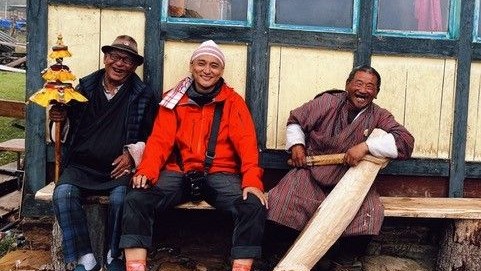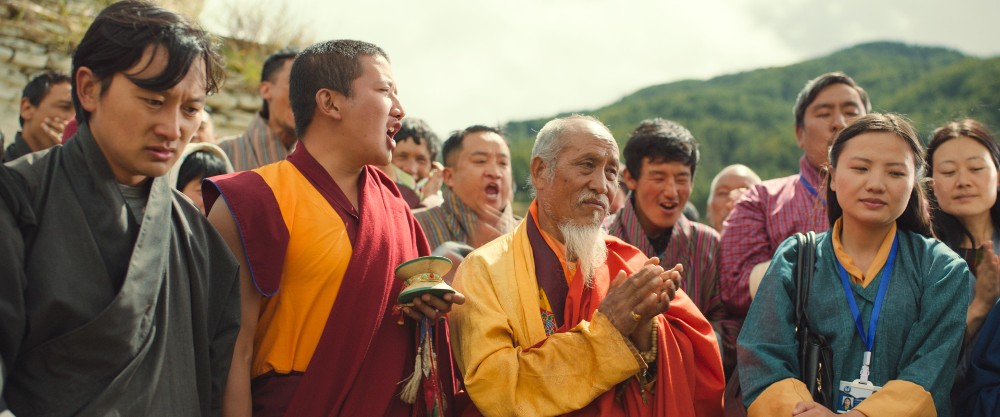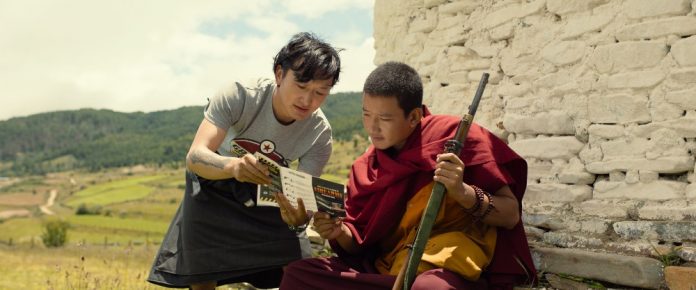Probably one of the most amazing phenomena that came out of the pandemic in regards to cinema and filmmaking is that the relatively innocuous Southeast Asian country of Bhutan began to make headways into the world cinema market. In large part, that was due to filmmaker Pawo Choyning Dorji’s film, Lunana: A Yak in the Classroom, only the second Oscar submission ever from the country, and one that was disqualified the year it was submitted. A second time submission was the charm though, as Dorji’s debut feature not only was shortlisted but also received one of five International Feature Oscar nominations, generating a lot of interest from its unique title.
Two years later, the filmmaker has returned with The Monk and the Gun, another film that’s firmly set in the culture and tradition of the country but shows one village beginning to discover both the good and bad of the outside world. It’s 2006, and Bhutan is going through changes with the introduction of television and the internet, but the burgeoning country has also decided to give democracy a try, as it prepare for its very first election. As the film’s title might imply, it follows a monk (Tandin Sonam) from a small Bhutanese village, trying to get his hands on a gun at the request of his lama, for reasons we won’t learn why until later. At the same time, an American (Harry Einhorn) has arrived to get his hands on a rare Civil War-era rifle that’s been found in another nearby village, and he calls upon the local Benji (Tandin Sonam) to help him make a deal to procure it.
Above the Line had a chance to speak with the filmmaker about how making The Monk and the Gun was a different experience than making Lunana, even though he maintained some of the same general principles to make it.

Above the Line: Lunana actually was made a few years ago, so how long after that was finished did you start making The Monk and the Gun?
Pawo Choyning Dorji: Actually, right after Lunana, I was working on the script, I was in pre-production, and then, of course, Lunana ended up getting nominated for an Oscar, so this had to wait while I went to the US for Lunana‘s campaign. Also, The Monk and the Gun‘s actual production was delayed a little bit because of the pandemic. Bhutan had one of the strictest COVID policies in place, where sometimes, if you leave the country and come back, you have to be in quarantine for over three weeks. Even until 2022, when we actually were shooting in the Fall, there were still very strict COVID policies in place. All our crew members still had to do five days, it was very strict.
ATL: What was the initial idea that got you started on this? Obviously, the election is a big part of the story. I don’t know if the election in 2006 was as crazy as it seems from the movie, so what were some of the ideas that brought this all together?
Dorji: For me, I am someone who takes a lot of inspiration from true events. Even Lunana: A Yak in the Classroom, a lot of it was based on true accounts of stories that teachers shared with me. There was a teacher who put a yak in the classroom, and even with this film, we did have a mock election in 2006, and yes, the yellow party did win, and people did not want democracy coming in. We did become the world’s last country to connect to the television and internet in the mid 2000s, and for me, personally, I come from a country that’s very unique, very isolated, that was one of the most isolated countries in the world. It was a policy of isolation that was put in place, because we wanted to preserve our way of life, our culture – that’s just the way we were. Interestingly, for me, I grew up all over the world. Being a son of a diplomat, I traveled the world, I studied politics in the US, and I think it was my background, growing up around the world, multicultural, studying politics and seeing how democracy was something that was so venerated in the US. At that very same time, when I was in the US, Bhutan was going through this process of modernization and democratization, and I found it very ironic that this gift that was so cherished in the modern Western world, was something that the people in Bhutan did not want. I thought it would make an amazing story. The final inspiration was during the pandemic, where I was stuck in Bhutan for about six months, and I went to build a Stupa. I witnessed the things that went inside the Stupa. Of course, the monks, they did not have actual guns, so they were burying toy guns, but they told me about the symbolism of it, and I thought, “Oh, wow, what if everything came together like this? It would be an amazing story to tell of Bhutan.”
ATL: As an American, it’s hard not to watch this movie and not think of it an indictment of America, where we make such a big deal about democracy, and yet, it leads to so many arguments. The scene where the townspeople are arguing between red and blue, that’s basically our country… and then you add in the fact that it seems like everyone here owns a gun.
Dorji: I think a big part was my spending time in the US, studying politics, being aware of the gun culture there, but also democracy.
ATL: How hard is it to get a movie up and running in Bhutan? What is the infrastructure in terms of having cameras and other equipment?
Dorji: It’s amazingly difficult. When we made Lunana: A Yak in the Classroom, we had one camera. We had solar batteries, and I always joked with my crew that I said, “If this movie fails, we can just take pride in making a film that was carbon negative.” Of course, with that, we had crew members who were working on a film set for the first time. My cast in Lunana, forget about having [never] acted in the film before – they had never seen light bulbs, they had never brushed their teeth. They had never been outside the village, so yes, it is extremely challenging to make a film in Bhutan, but then, I feel like there’s a lot of authenticity, and that shines through. The innocence shines through. Recently, a Bhutanese documentary film made it to Sundance – it’s called Agent of Happiness. A lot of people started messaging me, and they’re like, “Oh, did you know about this?” And I was like, “Yeah, of course, I know.” The director, Arun [Bhattarai] is a good friend of mine, and the filmmaking circle is very small. Just to let you know how difficult it is. Agent of Happiness and Lunana: A Yak in the Classroom were shot with the same camera. [laughs] It was a Canon C3 Mk II, and it’s amazing that the two films that are taking Bhutan to the west, to the US – one was Oscar-nominated, one is premiering in Sundance – both were shot with only one camera. [laughs]

ATL: What about getting the actors for The Monk and the Gun? Is there any sort of pool of television or stage actors, maybe in the bigger cities, from which you could cast?
Dorji: For The Monk and the Gun, because we had such a big cast – it was really an ensemble – I kind of experimented with the local film industry. We have a very, very small, local film industry that is very Bollywood-inspired, so a lot of singing and dancing in the rain. We had that kind of industry, and I wanted to experiment with that. So the guy who plays Benji, the [actor] who plays Tshomo, the mother, they are from the local industry, so experienced local actors, very different kind of acting, and then the rest are all first-time actors. That is something that I’ve had to do with both my films, cast non-professionals, more looking at their own character, their own personal lives, and seeing how I could relate that on screen. A lot of them are playing themselves. For example, the lama is the lama of the village. He is the only lama in the village, and he was building a Stupa, so the whole time, he was just being himself. A lot of the children as well, the farmers that you see in the thing, they’re all playing themselves. Both Yak and The Monk have a very docu-feature approach, not because I wanted it like that, but because that’s the cause and conditions I’m faced with to make films in Bhutan. Like I said earlier, I think when you do it like that, authenticity comes through, and when you get to a place where authenticity and performance meet, then it comes out great.
ATL: You mentioned how Bhutan is trying to be solitary, but you do realize that between your two movies, people are going to see them and want to go to Bhutan. To me, it seems very relaxing and calming and different than what I’m used to in New York City. Have you talked to the Bhutan tourist board about preparing for an influx of tourists?
Dorji: I think with both my films, it has really put Bhutan on a global platform where people can visually see and relate, and have the desire to visit Bhutan, and I think that’s great. For me, as a filmmaker, I feel like I have a very important responsibility. There aren’t many filmmakers in Bhutan, and I’m one of them, and I think it is through our films that we preserve our way of life, our culture, at the end of the day. Film is the most powerful medium through which we can share stories, and in a way, yes, we are sharing Bhutan with the rest of the world, but we are also doing something that is even more important – we are preserving our way of life, both with The Monk and the Gun and Lunana. The Monk and the Gun is about this change and transition that the country went through that many younger Bhutanese, like my children, they were not even born then, so they weren’t aware. I think it is the story of how, in pursuit of something we thought we needed, we ended up losing what we already had. To understand where we are headed, we have to know where we are coming from. I think films are doing great to share Bhutan, but more importantly, preservation of our way of life, our culture for future generations. That’s even more important.
ATL: Have you been using your newfound global status as a filmmaker there to get others interested in filmmaking, learning how to use the equipment, and things like that?
Dorji: Yes, yes, definitely. For Bhutan, being such a small underdeveloped country, I think the country needs people to be models to follow. I think that’s what was so magical about both Lunana‘s Oscar nomination and The Monk‘s Oscar shortlist. It is that there finally was something from Bhutan that the world was looking up to, but also the younger Bhutanese. Definitely I am always getting messages and emails from Bhutanese artists, youth, who want to express themselves, who want to also make films and be in the arts, and I think that’s very, very beautiful.

ATL: I was impressed that this small Bhutanese village managed to get the James Bond movie Quantum of Solace on television years before the movie was actually made.
Dorji: That was the trailer. [laughs] I was also growing up at that time in Bhutan, and it was amazing because, for the rest of the world or the US, there is not that one moment where you can say, “Oh, this is the moment where I saw TV for the first time,” right? We grew up with it, it was part of our childhood, it’s part of our life. But for many Bhutanese, they can actually say, “Oh, this was the moment that this black box came into our lives and changed everything.” When TV was not allowed, it was a different life, and then after TV came in, it was a different life. When TVs came out, just as I showed in the film, it totally changed society as we know it. As I mentioned, people were selling their cows, their homes, their land, to get this box, then everyone would crowd around every night to watch films.
Overnight, icons of the Western world became cultural icons for Bhutan. That scene where the little girl is peeling off the posters of the Buddhas and pasting on James Bond, that actually happened. The interesting thing is even Rambo became this cultural icon in Bhutan. I know he came much earlier, but in Bhutan, suddenly they were able to relate to this figure so much with his bare-chested, red bandana, rocket launcher. People were going crazy for the Spice Girls, Backstreet Boys, WWF wrestlers, it totally changed everything and the impact it had all across the Himalayas, it was amazing to witness. I wanted to use that in the film. I wanted to use that as a reference for The Monk and the Gun, and to see the gun on TV, and suddenly be like, “That is what I want to be like, and that is what I want.”
ATL: It’s obviously been a while since TV was introduced in Bhutan, so has it become much more commonplace, even in these smaller villages?
Dorji: It’s much more common. Something I always say with this film – I’ve even put it up on the posters and in the press kit – it’s [about] innocence. I come from a country and a culture that is rooted in tradition, in the teachings of the Buddha, and if you visit Bhutan, you will notice this. It’s much less now, but we are a culture that really, really celebrates innocence. It’s a fundamental quality of who the Bhutanese people are. When this change came in TV, internet, democracy, and in a way, guns, you could say that quality was lost, because in the modern world, to be innocent is to be ignorant. And that’s what I wanted to touch upon with this film.
ATL: I think the next thing is to have a local film festival where you can bring in Sylvester Stallone or some of these cultural icons from the West to see Bhutan.
Dorji: That is our hope next, but first we need to build cinemas. [laughs]
ATL: It’s so nice to meet you, and I can’t wait to see what you do next. These two films are quite wonderful, and just so different from the films we normally get here.
Dorji: Thank you so much. For me, I want to grow as a filmmaker, because I’m Bhutanese. We don’t have film schools there. Like I said, we don’t even have proper cinemas. So as an aspiring filmmaker, I had to just dive into it. Lunana was my first piece, and then, with The Monk and the Gun I really explored and wanted to see how I could grow from Lunana, so your words mean a lot to me. Thank you.
The Monk and the Gun is now playing in select cities across the country.



